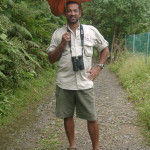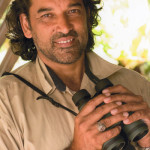The Ecologist
CASE STUDY: Keeping tourism in balance with nature
Eifion Rees
5th January, 2010
Irshad Mobarak, a self-taught naturalist and environmentalist from the Malaysian island of Langkawi says that development need not mean destruction.
It’s a simple equation: cleared forests equal cleared hotel rooms.
Tourism is a double-edged sword in Langkawi. With its turquoise seas and white beaches, 80 per cent of the economy of this Malaysian archipelago of 99 islands is linked to tourism, but overdevelopment and rainforest clearances are threatening the natural attractions that draw people to its shores.
What sets it apart from its rivals in the region – Bali, Phuket and Penang, where the nightlife is glitzier, the beaches more beautiful and the shopping more plentiful – is its geography and biodiversity. Expanses of moss-green rainforest, mangrove swamps, tree-clad limestone mountains, coastal forests, mudflats, marine parks of hard and soft coral, 220 species of birds, many mammals, dolphins, migrating whale sharks and other wildlife.
Intense logging over the years has taken its toll, however, and continues today, despite Langkawi’s forests being protected. With more than half its precious natural heritage lost, the ‘Jewel of Kedah’ (Kedah being the mainland state to which Langkawi belongs) is at a tipping point.
It is something that Irshad Mobarak, a self-taught naturalist who has been working on Langkawi for the past 23 years, is determined to do something about.
Jungle hero
In 1994 he set up JungleWalla, a company offering nature, wildlife and birdwatching tours to visitors, and spends the rest of his time overseeing the many conservation projects he has initiated. He uses the diversity and interdependence of the rainforest as an object lesson in how we ought to see our relationship with nature.
Jobs may matter on the island, but destroying whole ecosystems to make way for new developments or to create farmland is a shortsighted approach. ‘Not to protect Langkawi’s natural capital is economic suicide,’ Irshad says.
A charismatic and well-known character on the island, he won an ‘Amazing Malaysians’ award in 2007 for his environmental work, and is currently galvanising support for the rainforest through a series of talks to hotels and hospitality industry staff, the bedrock of the tourism industry. He aims to collect 4,000 signatures on a petition calling upon Langkawi’s authorities to do more to protect the islands’ natural heritage.
‘Those who are native to the island have most to lose,’ he says. ‘The destruction of their natural heritage not only jeopardises their jobs in the tourism industry, but also will impact on the farming and fishing industries, and ultimately on their quality of life.’
An education
The focus is on educating as many islanders as possible, with the petition demanding that all remaining wildlands be totally protected from development and illegal encroachment, for the sake of the island’s water security, to mitigate climate change, flash floods and water pollution into rivers and seas, and for the sake of the island’s ecotourism industry.
Environmental activism is not commonplace on Langkawi, however, and the authorities on the whole seem wary of Irshad’s approach. Small wonder, when some are part of the problem. On a national level, Malaysia has severe problems with logging, and Irshad says on Langkawi it is an open secret that much encroachment into forested areas is indirectly supported by local political figures. Logging teams start deep within the jungle and cut their way out; vast swathes are cleared before anyone notices what is happening.
In a recent town hall meeting in Kuah, Langkawi’s main town, in front of more than 300 people, Langkawi’s highest-ranking state official, the district officer, spoke out against organised illegal encroachment and deforestation by groups of as many as 70 people with the quiet backing of local political figures. ‘When the time comes to apply for the legal papers for these newly cleared lands it is not the poor benefiting, but richer individuals who already have land elsewhere,’ says Irshad.
The disconnect between the powers-that-be and the great environmental issues facing Langkawi, and Malaysia as a whole, are exemplified by Kedah’s Menteri Besar (state governor) Azizan Abdul Razak, who said last year that opponents of deforestation shouldn’t ‘be too obsessed with caring for the environment, like parents who are extremely obsessed with their offspring’.
Habitat loss and the island conundrum
Islands are particularly prone to environmental degradation, home to half the 724 known animal extinctions in the past 400 years and 90 per cent of bird extinctions. With a limited geographical range, unique island species are more likely to succumb to disease, fire, bad weather and normal fluctuations in population, all exacerbated by human action.
The warning signs are already there on Langkawi. Illegal encroachment into wild areas to build roads, hotels and other developments is dividing wildlife habitats. As the rainforest dwindles, the land loses the ability to soak up heavy rainfall, making flash floods more common, destroying the island’s pastures and paddy fields.
Run-off from the land spills into the sea, affecting fish stocks already damaged by unsustainable fishing practices. Unsustainable agriculture is adversely affecting biodiversity. Local people torch scrub to clear more land, triggering bush fires in the dry season.
Poaching has decimated popubutterfly, many of which are found nowhere else on the planet, as well as 220 species of bird, including the Wreathed, Pied and iconic Great Hornbill. All are threatened by the loss of habitat on Langkawi: 49 per cent has already been destroyed; the remainder has been heavily fragmented into six smaller and isolated ‘island habitats’ within the archipelago itself.
Valuable assets
‘Langkawi is experiencing an unprecedented level of habitat loss and fragmentation,’ says Irshad. ‘Animals can no longer move safely from one part of their habitat to another to feed, breed or to patrol their territory. This may result in inbreeding and eventually a decrease in the viability of the species’ gene pool, causing extinction. Loss of habitat compounded by habitat fragmentation is the biggest threat to the island’s natural biodiversity. The island is in grave danger of losing its most valuable asset.’
Langkawi markets itself as an ecotourism destination, and Irshad’s message is that development needn’t mean destruction. As well as his campaign of education and petitioning the authorities, he has a wealth of alternative suggestions for how the rainforest can provide for the people [see box below] – none of which involves a chainsaw. Irshad says there is a growing awareness among Langkawians that they have a stake in protecting their ecosystems and biodiversity, and he feels positive about the future.
‘More effort needs to be made, but I am optimistic that we can reach a place where there is equilibrium between the needs of people and the needs of nature.’
On an island in thrall to the tourist dollar, the appeal to the bottom line seems guaranteed to get results – especially given that elections on Langkawi are usually won by slim margins of as little as 600 votes; the recently set-up Langkawi branch of the Malaysian Nature Society, with Irshad as its chair, which will help add more weight to the cause.
It’s a simple equation: cleared forests equal cleared hotel rooms. Halting and reversing this trend on Langkawi would be an important sign that the tourist industry has learned that it depends on its forests, and cannot afford to destroy them.
If Irshad Mobarak’s campaign yields results on Langkawi, it may not be long before his attitude towards environmental protection – infectious and positive; a rare and unique species in itself – breaks out from the islands and begins to repopulate the mainland.
Eifion Rees is a freelance journalist
Precision farming: Irshad Mobarak, naturalist, Langkawi
‘Why remove the rainforest to rear non-indigenous beef cattle when you can farm mouse deer or rusa within a rainforest?’ Irshad asks. ‘The price of venison is two to three times the price of beef, and much healthier. It is a known fact that wild honey is five to 10 times more nutritious than the imported honey made using modern techniques, so why not promote apiculture? To protect his own interests, the villager will become the guardian of the rainforest around him.’
Instead of rainforests being devastated by the monoculture farming practices associated with growing rubber, palm oil, cocoa or livestock, Irshad aims to show that farmers can tap into natural ecosystems to earn a living – what he calls “eco-wisdom” in farming – without having to chop down trees. The rainforest consists of emergents (above 40m), canopy (30m-40m) and understorey (below 30m), each with distinct microclimates and flora.
Irshad is developing an experimental multi-tiered farm he hopes will prove that one hectare of rainforest can make more money than one hectare of monoculture, shifting the cash incentive towards protection instead of destruction. The first phase – farming mushrooms and orchids, both high-value crops – has already proved a success, with a native tree nursery, woodcraft industry from fallen trees and the collection and selling of wild herbs to be trialled next.
 Previous Post
Previous Post Next Post
Next Post







